Day Two In Prague (Page Twenty-Two)
Today was a full day in Prague so we walked and rode all over town.
Did You Know? - It was in Prague that Pluto was taken down a peg. The general assembly of the International Astronomical Union, which gathered Aug. 14–25, 2006 in the Czech capital, voted to redefine Pluto as a “dwarf planet” rather than a full-fledged planet, thereby decreasing the number of official planets in the solar system from nine to eight.
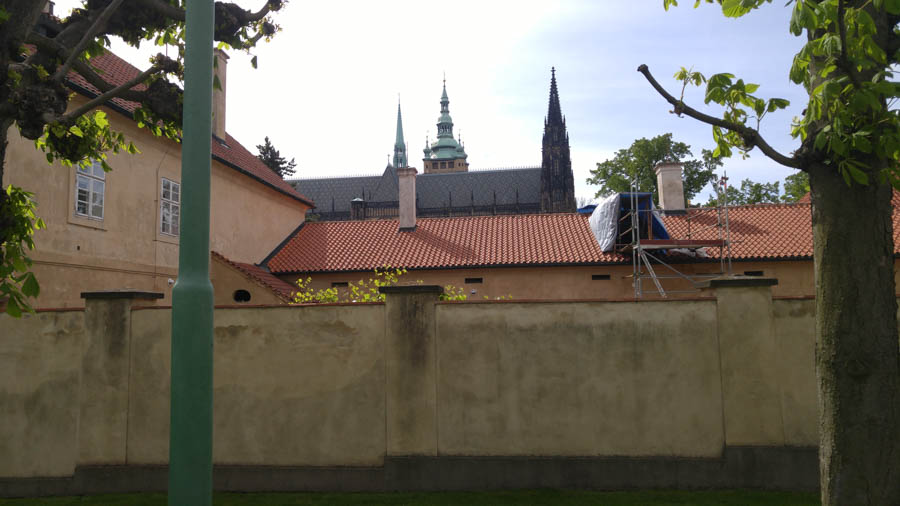
Many homes have walls to separate their gardens from the streets

They love their gardens
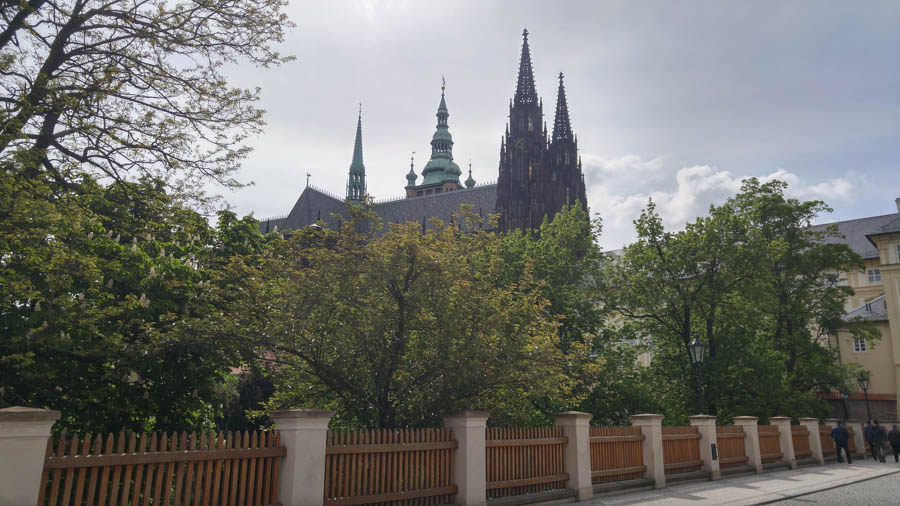
You can see the Metropolitan Cathedral of Saints Vitus, Wenceslaus and Adalbert which is located within the Prague Castle
Did You Know? - The Metropolitan Cathedral of Saints Vitus, Wenceslaus and Adalbert is a Roman Catholic metropolitan cathedral in Prague, the seat of the Archbishop of Prague. Until 1997, the cathedral was dedicated only to Saint Vitus, and is still commonly named only as St. Vitus Cathedral.
This cathedral is a prominent example of Gothic architecture and is the largest and most important church in the country. Located within Prague Castle and containing the tombs of many Bohemian kings and Holy Roman Emperors, the cathedral is under the ownership of the Czech government as part of the Prague Castle complex.
Cathedral dimensions are 124 by 60 meters (407 ft × 197 ft), the main tower is 96.5 meters (317 ft) high, front towers 82 meters (269 ft), arch height 33.2 meters (109 ft).

Entering the castle grounds via a short bridge

The guards stand inside their little houses!
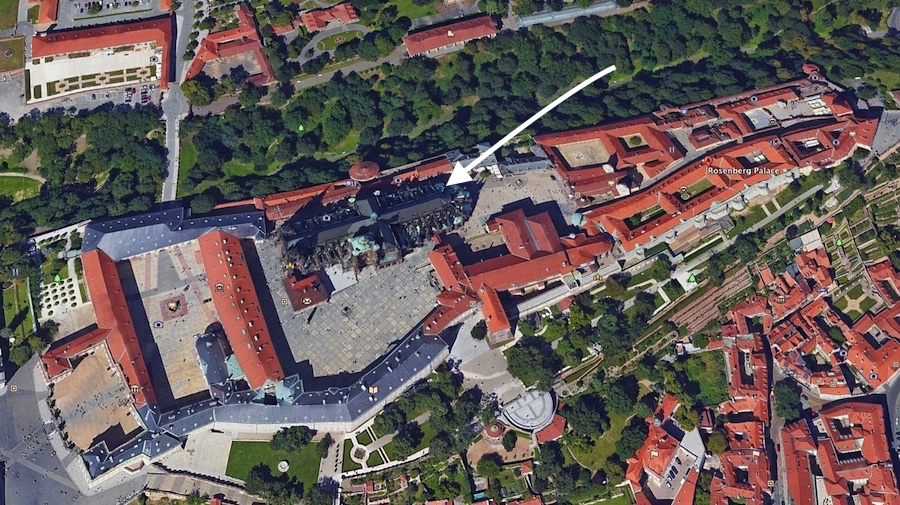
The church is totally within the grounds of the castle

Impressive stone work

The doors even make the people look small

The naive is huge (Click for a full sized image)
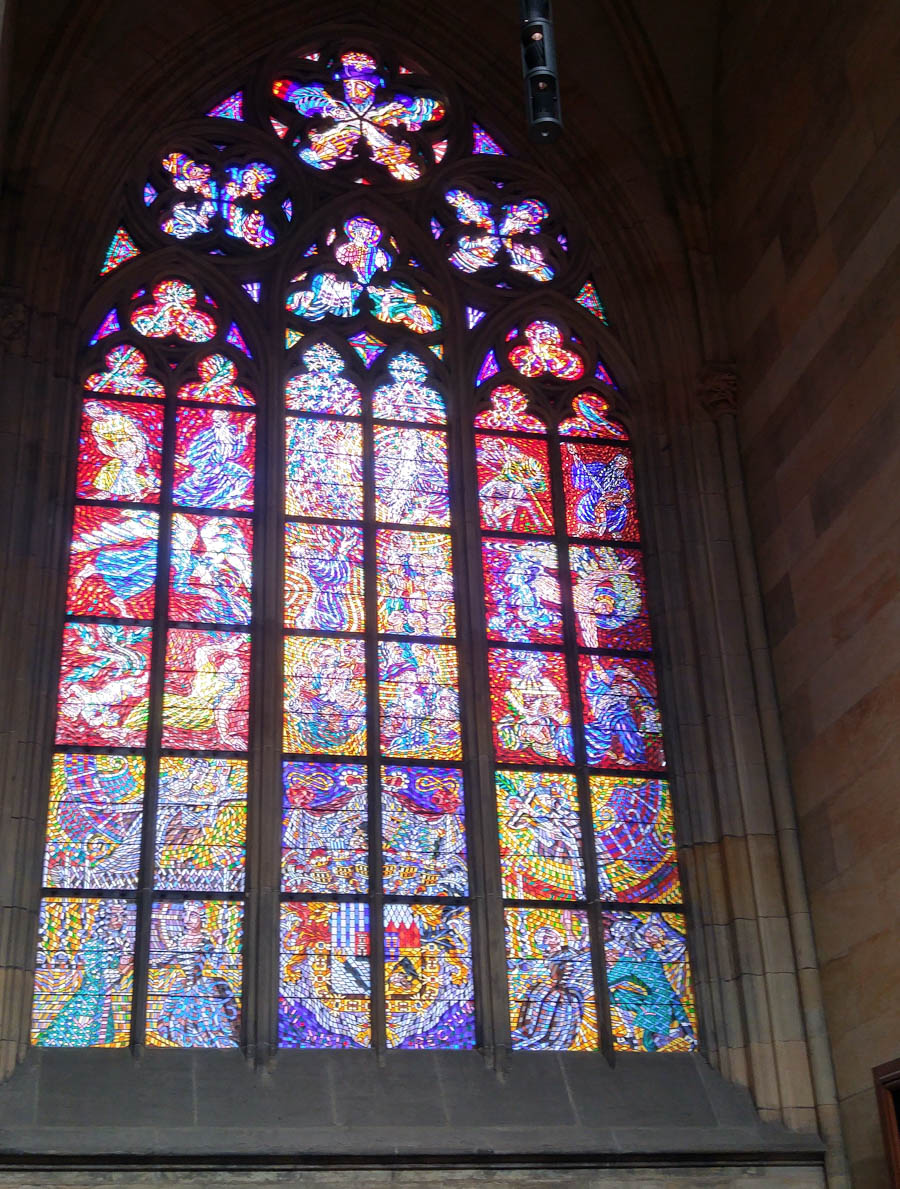
Amazing stained glass windows

Always under repair...
Did You Know? - There are four chapels on the ground of the castle:
- Katedrála svatého Víta, Václava a Vojtěcha (St. Vitus Cathedral)
- Bazilika svatého Jiří (St. George's Basilica, Prague) and Klášter svatého Jiří (St. George's Convent, Prague), it is the oldest surviving church building within Prague Castle.
- Chrám Všech svatých (All Saints Church)
- Kaple svatého Kříže (Holy Cross Chapel (cs))

Draperies are used to draw attention to certain locations within

The pulpit is very ornate and rises up 30+ feet above the parishioners

Finally, the sun was at the correct angle for a picture

Picture time!!!

The entrance to the Cathedral (Click for a full sized image)

The Golden Gate at St. Vitiris

Did You Know? - St. George's Basilica (Czech: Bazilika Sv. Jiří) is the oldest surviving church building within Prague Castle, Prague, Czech Republic. The basilica was founded by Vratislaus I of Bohemia in 920. It is dedicated to Saint George.
The basilica was substantially enlarged in 973 with the addition of the Benedictine St. George's Abbey. It was rebuilt following a major fire in 1142. The Baroque façade dates from the late 17th century. A Gothic style chapel dedicated to Ludmila of Bohemia holds the tomb of the saint. The shrines of Vratislav and Boleslaus II of Bohemia are also in the basilica. The abbess of this community had the right to crown the Bohemian queens consort.
The building now houses the 19th century Bohemian Art Collection of National Gallery in Prague.
It also serves as a concert hall.
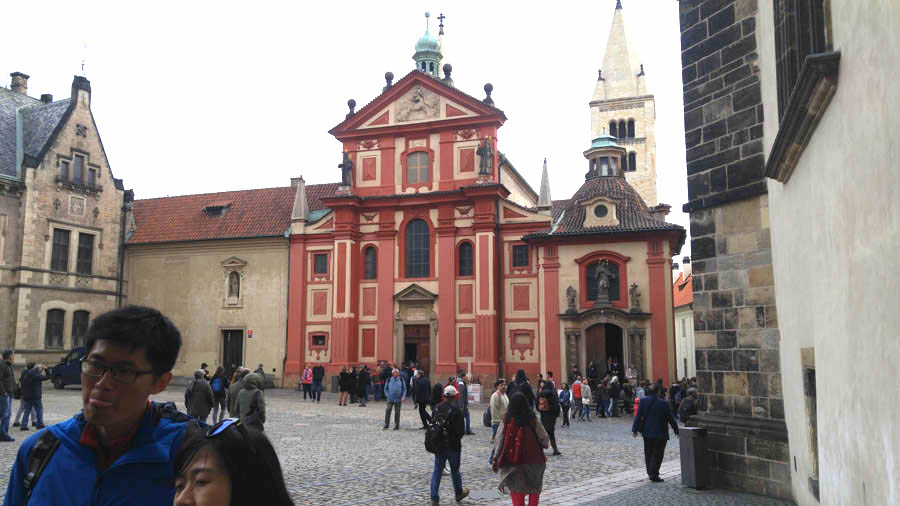
St. George's Basilica (Click for full sized image)
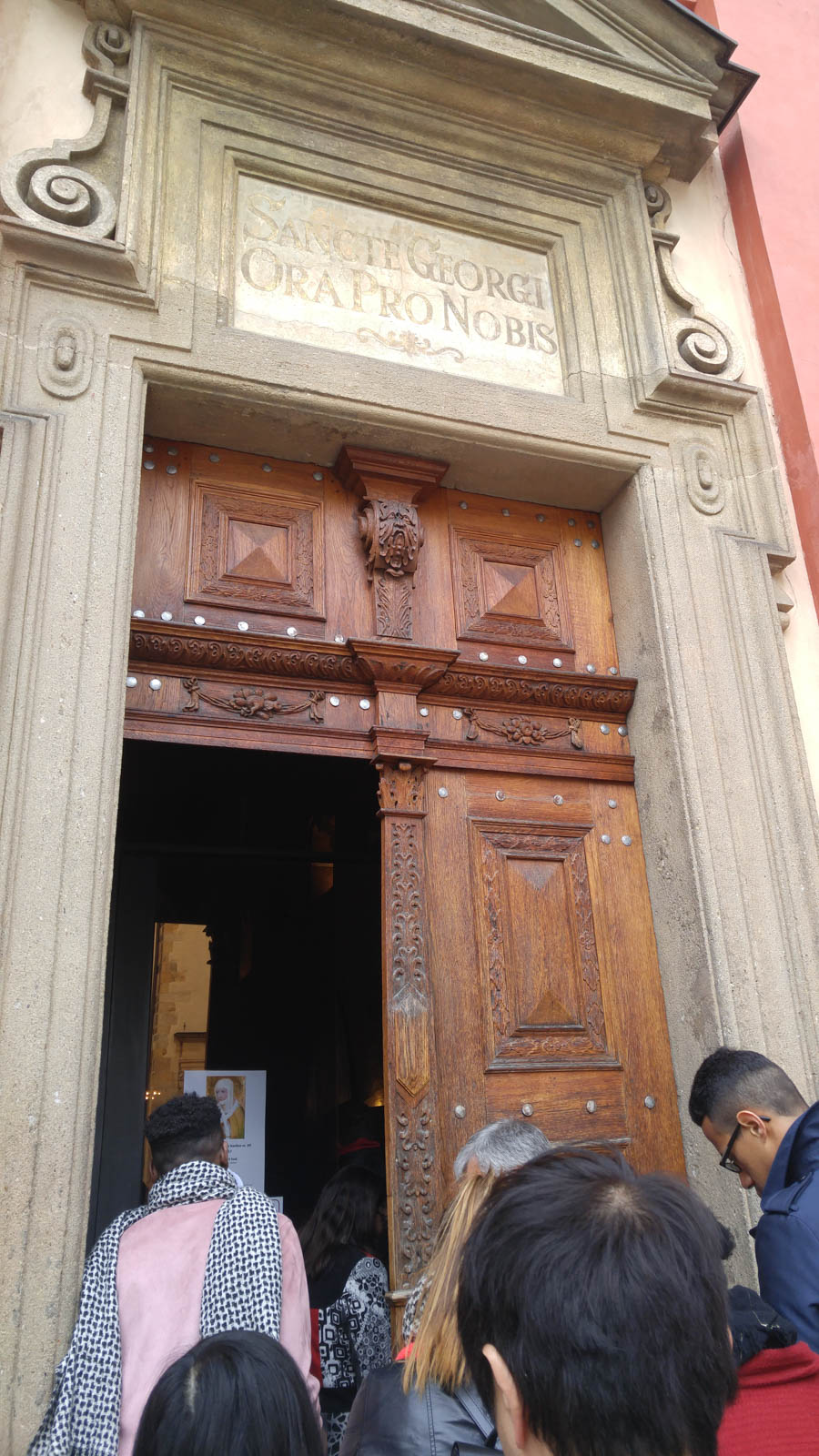
Come on in...
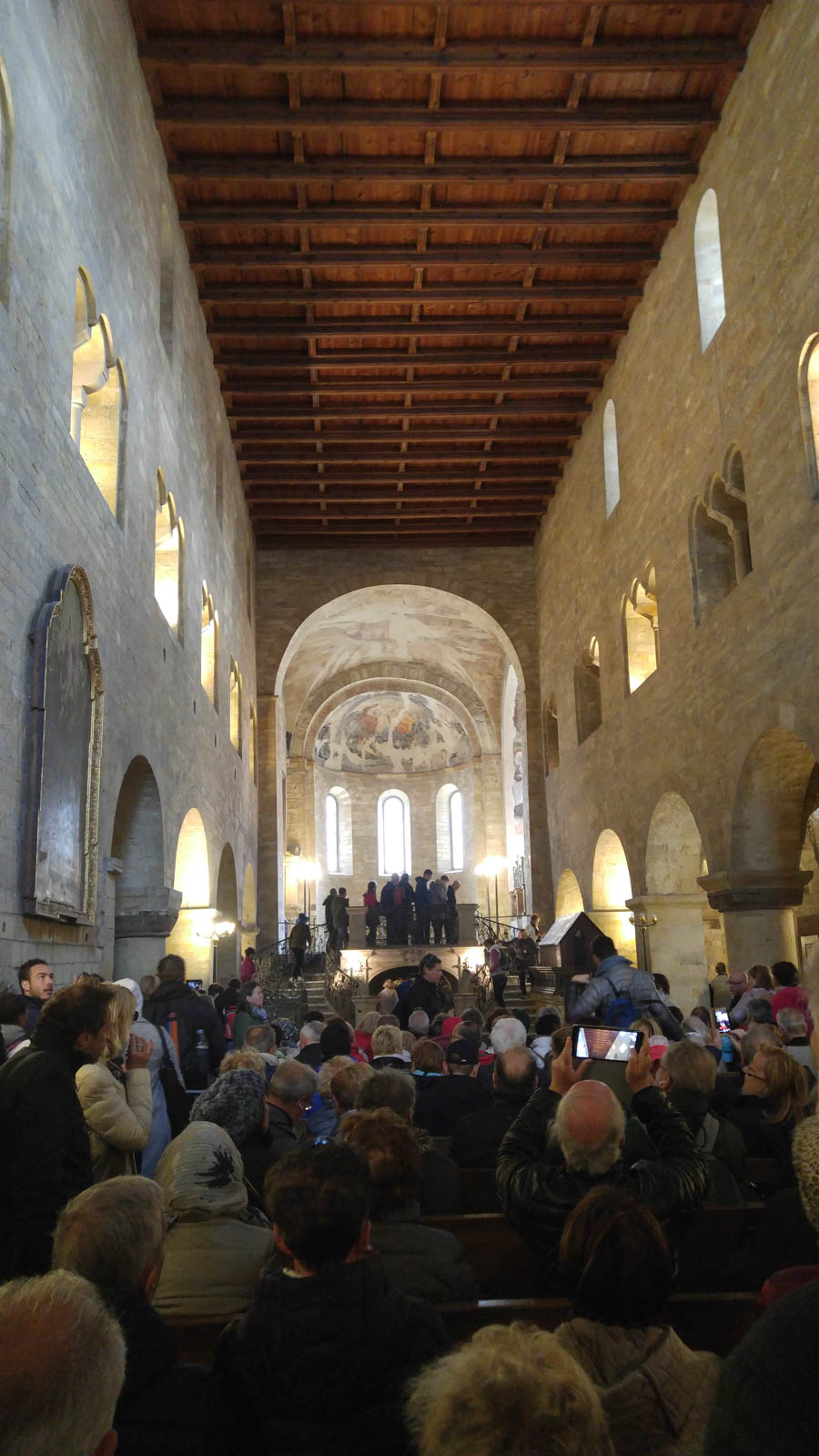
It was quite bust today
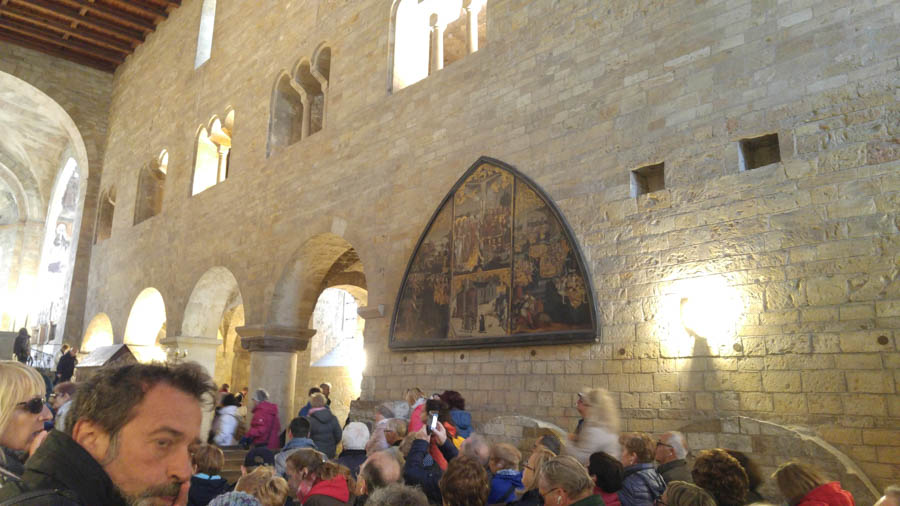
From the beginning of the 10th century... 1000+ years ago!

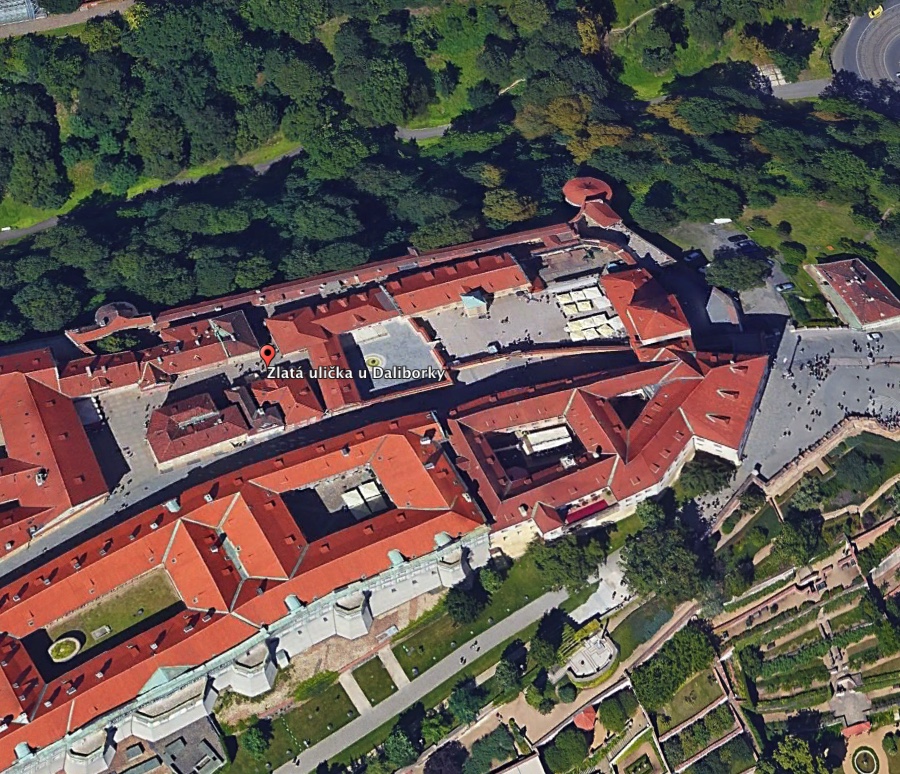
The name "Golden Lane" was taken from the
goldsmith's that worked there in the 1700's
Did You Know? - Golden Lane (Czech: Zlatá ulička) is a street situated in Prague Castle, Czech Republic. Originally built in the 16th century, to house Rudolf II's castle guards, it takes its name from the goldsmiths that lived there in the 17th century. Although the lane was temporarily called the Street of Alchemists or Alchemists' Alley, alchemists have never worked or lived there.
Golden Lane consists of small houses, painted in bright colours in the 1950s. The street originally had houses on both sides, but one side was demolished in the 19th century.
Today the lane is a part of the small and big castle rings (i.e. a fee must be paid to enter), while there is free entry after the Prague Castle interiors close. Many of the houses are now souvenir shops, and there is a museum of medieval armoury within the former 14th-century fortification accessible from Golden Lane.
House number 22 used to belong to the sister of writer Franz Kafka, who used this house to write for approximately two years between 1916 and 1917.
Jaroslav Seifert, who won the Nobel Prize in Literature in 1984 and who was one of the signatories of Charter 77, lived there in 1929.
Golden Lane is connected with Dalibor Tower, which used to be a dungeon.

By the numbers...
Did You Know? - Golden Lane dates from the 15th Century and has a beautiful, olden world quaintness about it. It comprises 11 historic houses, inside which period scenes have been created to show the life of the artisans who once worked, ate, drank and slept in them.
In the upper level of the houses are medieval armory and textile displays. Visitors can also try shooting a crossbow.
Golden Lane was created when a new outer wall was added to the existing Romanesque castle complex. It was originally known as Zlatnická ulička (Goldsmith's Lane), due to the many goldsmiths residing in the houses; some more alchemist than goldsmith!
In its early years Golden Lane consisted of even smaller dwellings. Eventually, as each fell into disrepair they were replaced by the houses we see today.


The displays were interesting revealing life as it used to be...

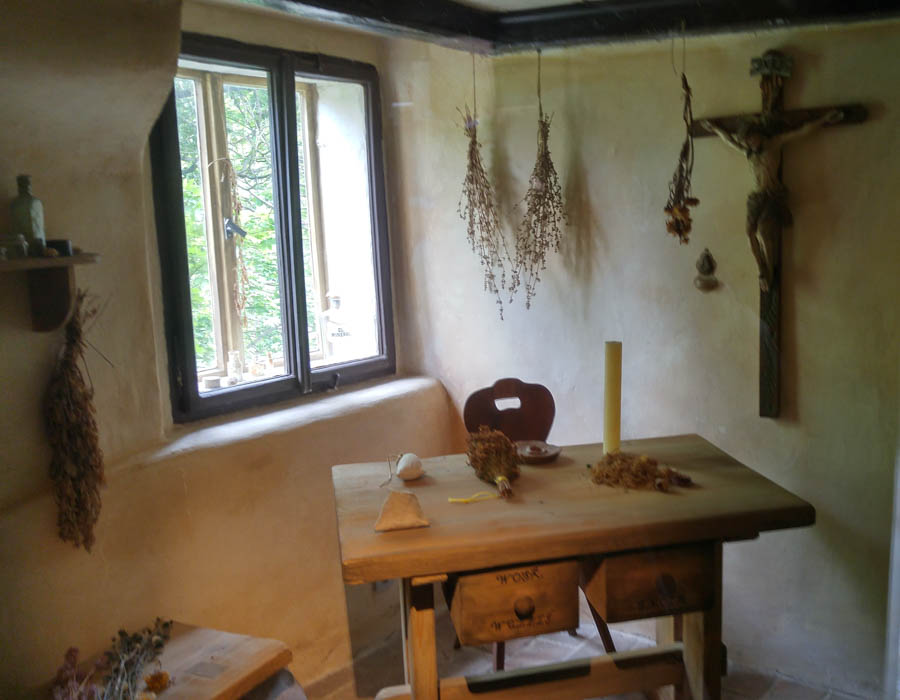
Where potions are mixed up
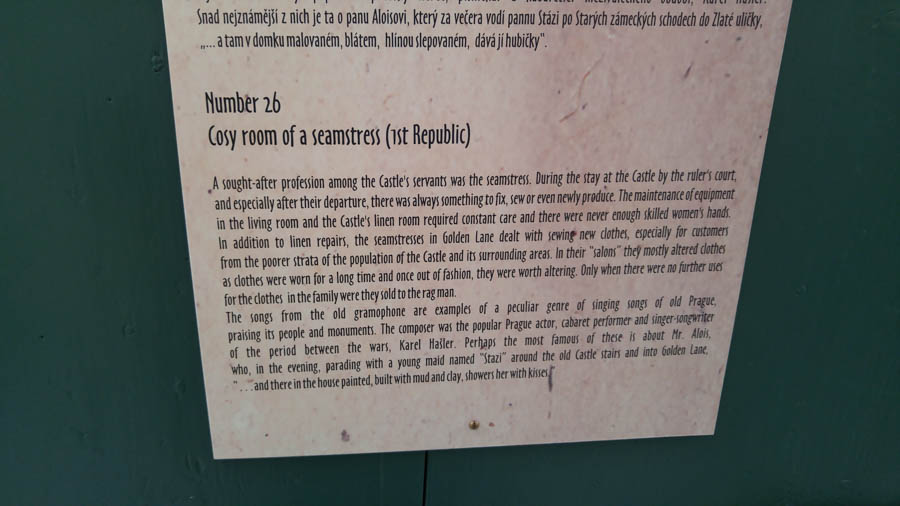

Small but cozy
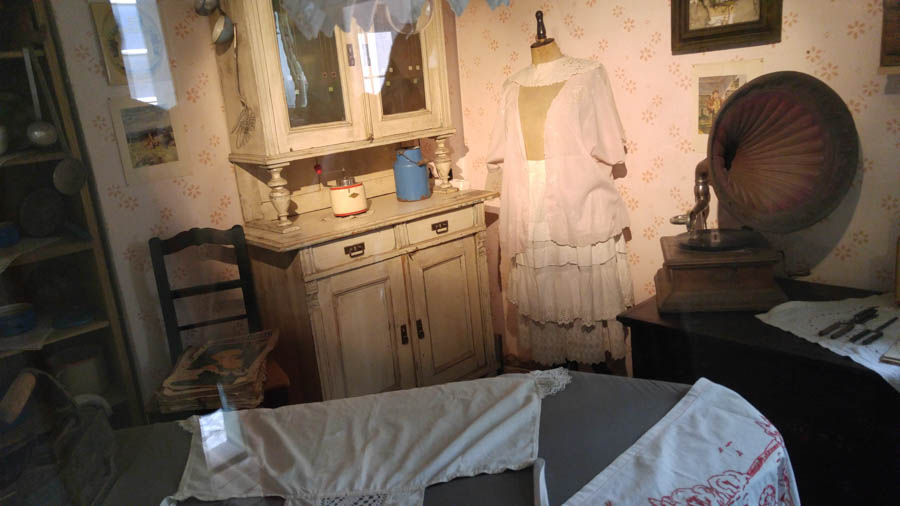
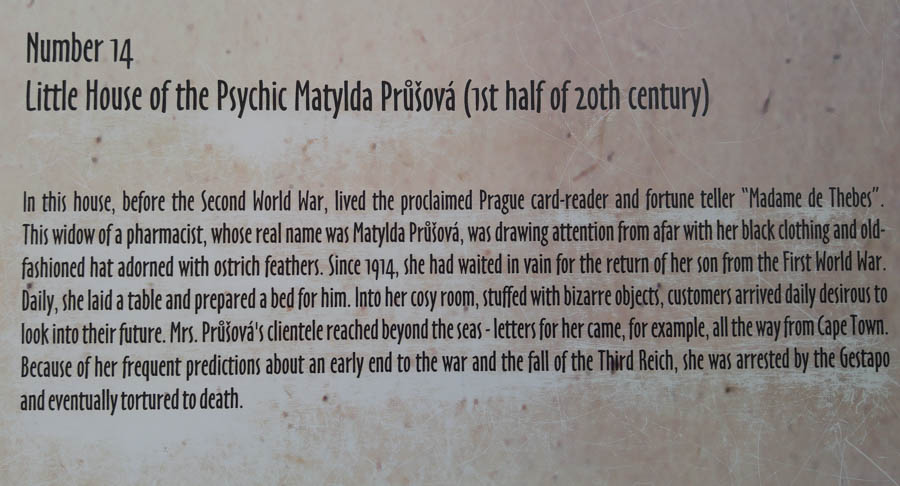


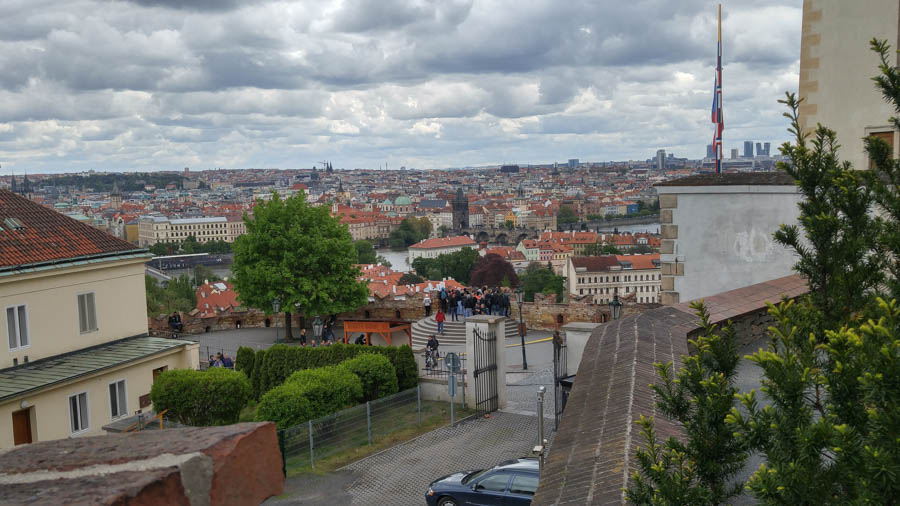
The Prague Castle complex covers over 7 hectares (18 acres) and is centered around three great courtyards.

Walking to the Rosenberg Palace
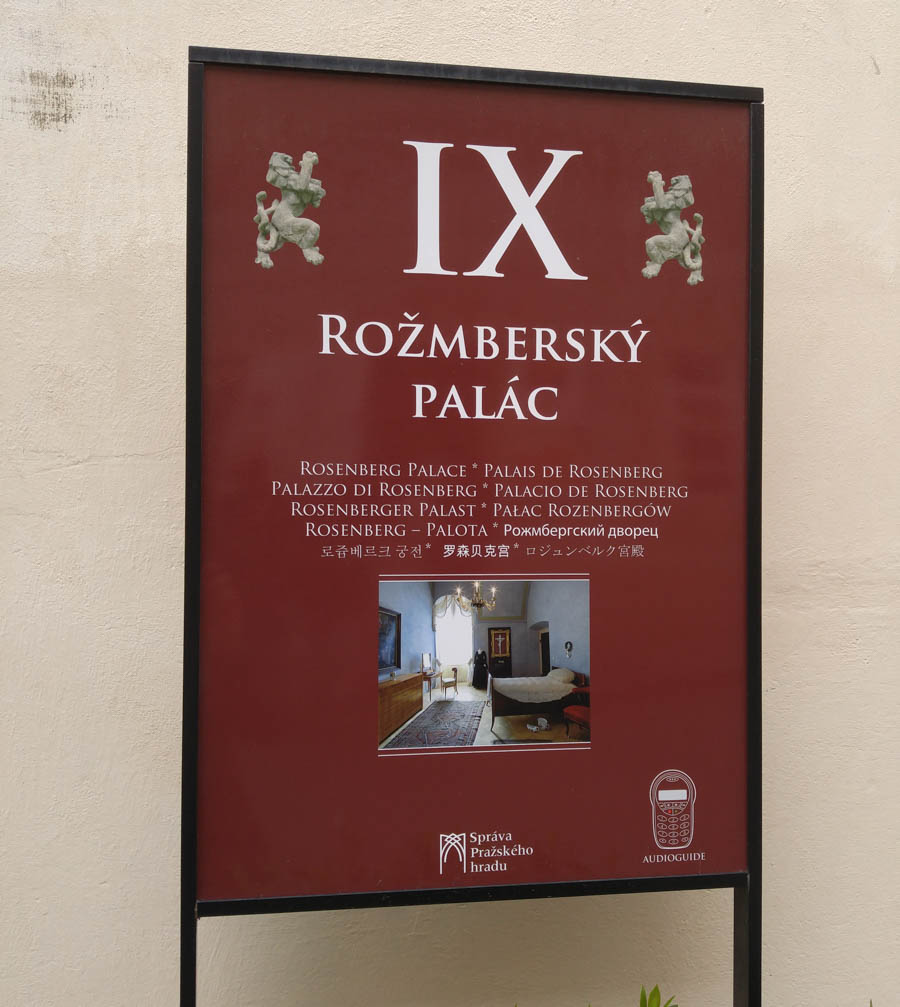
Did You Know? - This large palace is located in the Jirska street in the area of the Prague Castle. Originally a Renaissance palace of the noble family of Rosenberg, it was rebuilt in Baroque style and used as a residence for unmarried women from insolvent noble families.
There were several houses in the area already in the 13 th century, but they all burned down in the big fire at the Prague Castle in 1541. The nobles of Rosenberg, owners of the area, decided to build a large residence there. The entrusted architect Hans Vlach projected a Renaissance palace with four-wings, two of them with arcades. Rosenbergs later bought another part of the area and founded a large garden there, lined with an arcade gallery built by Ulrico Avostalis in 1574.
The Emperor Rudolph II. gained the palace in exchange in 1600. He ordered to build a wooden corridor to connect the building with the Louis Tract of the Old Royal Palace.
The Rosenberg Palace was rebuilt to be used as a Residence for Noblewomen in 1756. It was projected by N. Pacassi and built by A. Lurago.
30 poor noblewomen lived in the palace, all of them had to be 24 years old or older. There was only an exception for orphans, who could live there from the age of 18.
The symbol of the Residence for Noblewomen was a picture of the Immaculate Conception of the Virgin Mary in a golden oval medal. The residence was led by an unmarried archduchess from the Habsburg-Lorraine dynasty. The first abbess was archduchess Marie Anna, the Empress Maria Theresa´s daughter. The noblewomen lived in the first and second floors, in the other rooms there was a capitular room, a sacrarium, a chapel and the abbess apartment.
At the present time, yhe Residence for Noblewomen was abolished in 1919. The palace was taken over by the Ministry of the Interior for several decades. Nowadays, there are offices of the Prague Castle administration and the Office of the President of the Czech Republic.
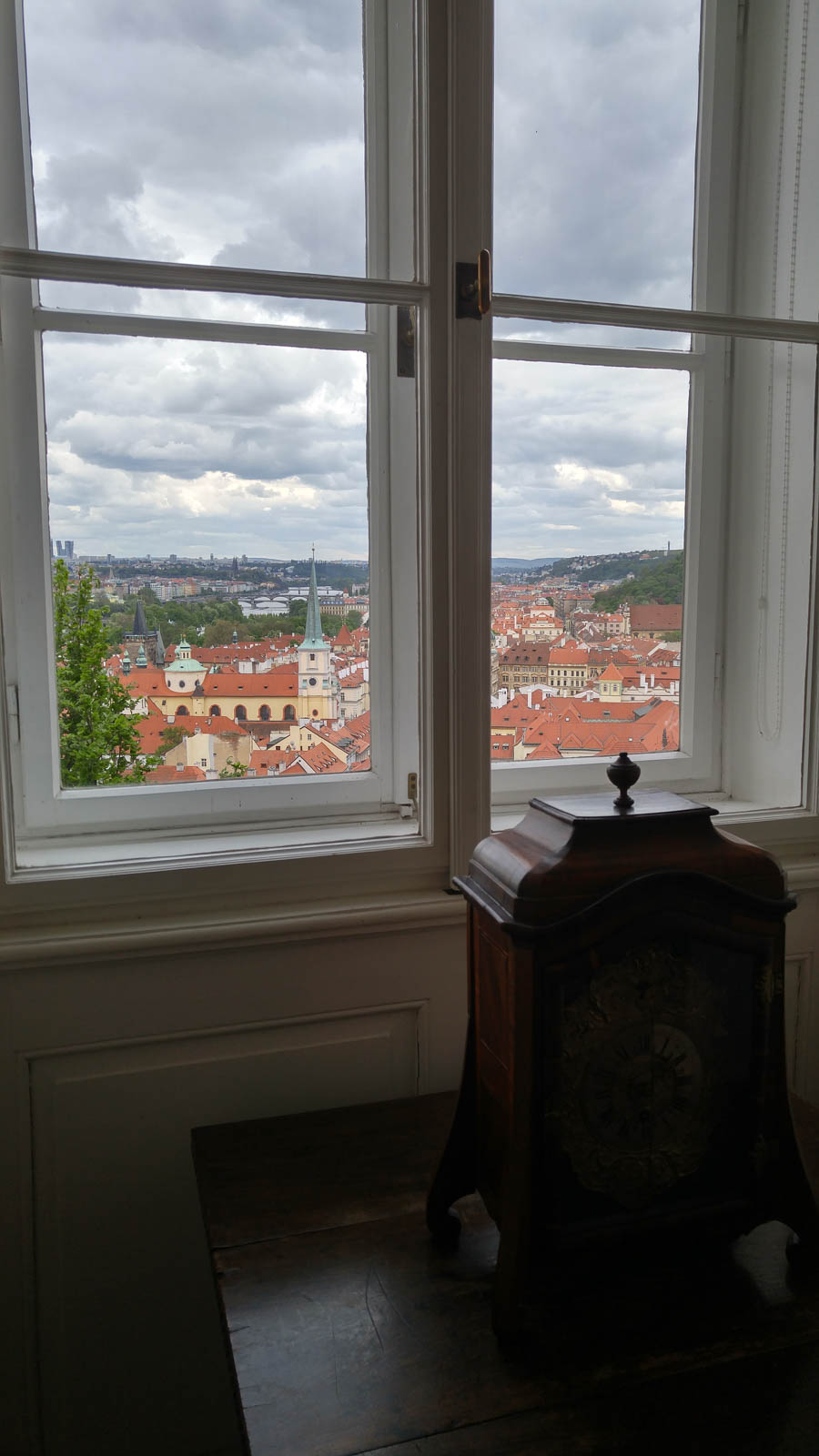
A wonderful view of the city

The roofs last forever as they are ceramic tile
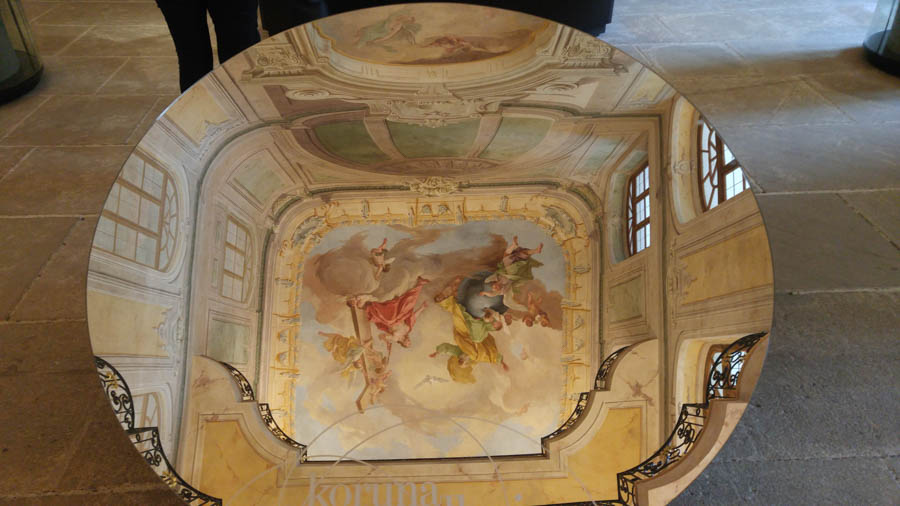
There are amazing fresco's within the Rosenberg Palace
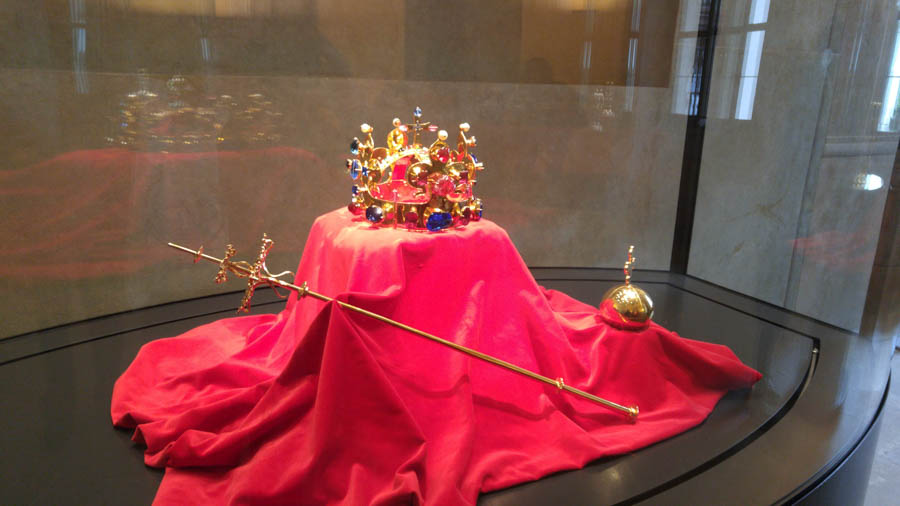
...as well as symbols of power

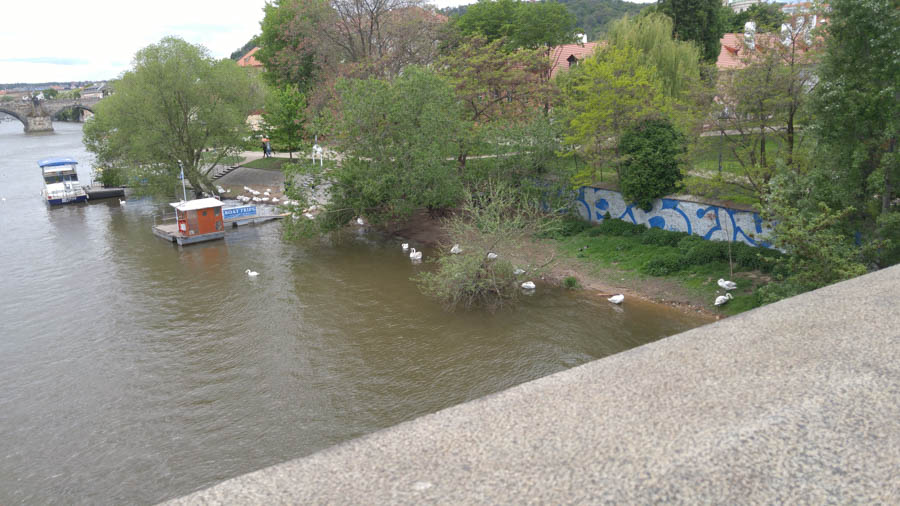
Graffiti? Guess it follows humans everywhere!

The
Rudolfinum

Of course, right on the river!
Did You Know? - The Rudolfinum is a building in Prague, Czech Republic. It is designed in the neo-renaissance style and is situated on Jan Palach Square on the bank of the river Vltava. Since its opening in 1885 it is associated with music and art. Currently Czech Philharmonic Orchestra and Galerie Rudolfinum are based in the building. Its largest music auditorium, Dvořák Hall, is one of the main venues of the Prague Spring International Music Festival and is noted for its excellent acoustics.
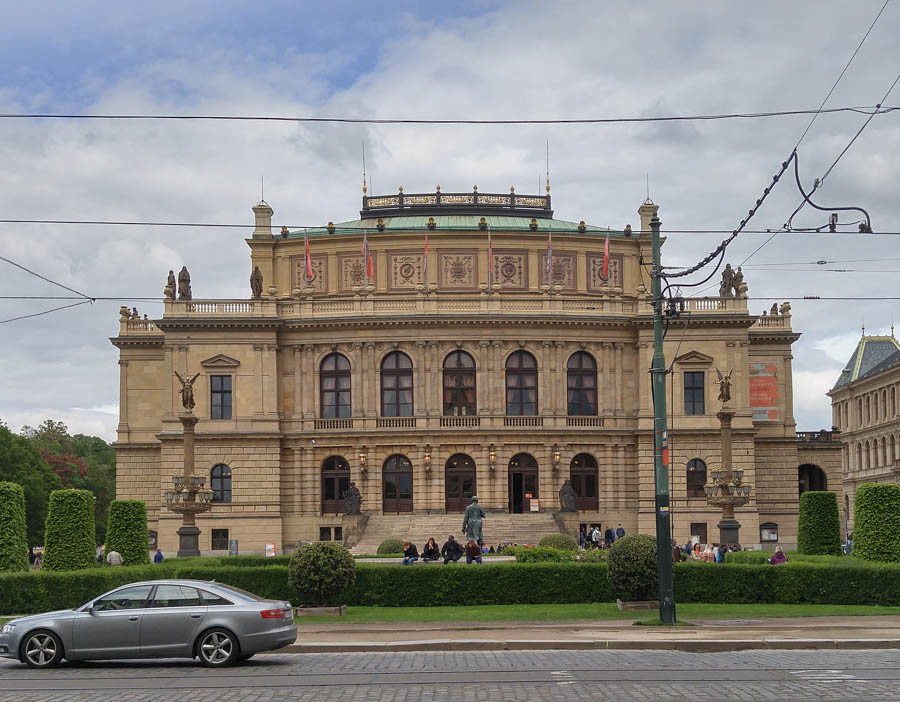
A beautiful building
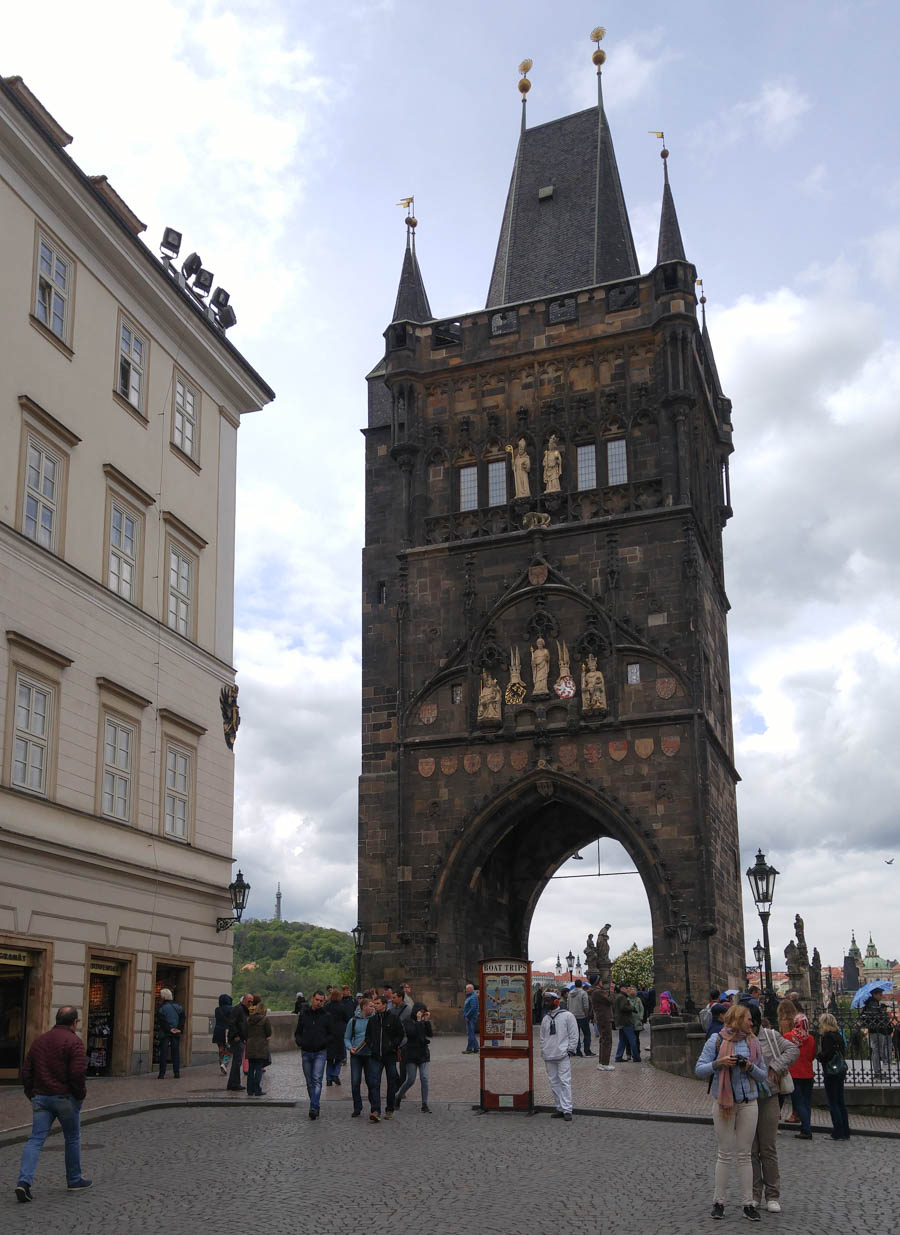
All roads lead to the Charles Bridge
Did You Know? - he avenue of 30 mostly baroque statues and statuaries situated on the balustrade forms a unique connection of artistic styles with the underlying gothic bridge. Most sculptures were erected between 1683 and 1714.
They depict various saints and patron saints venerated at that time. The most prominent Bohemian sculptors of the time took part in decorating the bridge, such as Matthias Braun, Jan Brokoff, and his sons Michael Joseph and Ferdinand Maxmilian.
Among the most notable sculptures, one can find the statuaries of St. Luthgard, the Holy Crucifix and Calvary, and John of Nepomuk. Well known also is the statue of the knight Bruncvík, although it was erected some 200 years later and does not belong to the main avenue.
Beginning in 1965, all of the statues have been systematically replaced by replicas, and the originals have been exhibited in the lapidarium of the National Museum.

A torture museum is a museum that exhibits instruments of torture and provides tutorials on the history of torture and its use in human society.
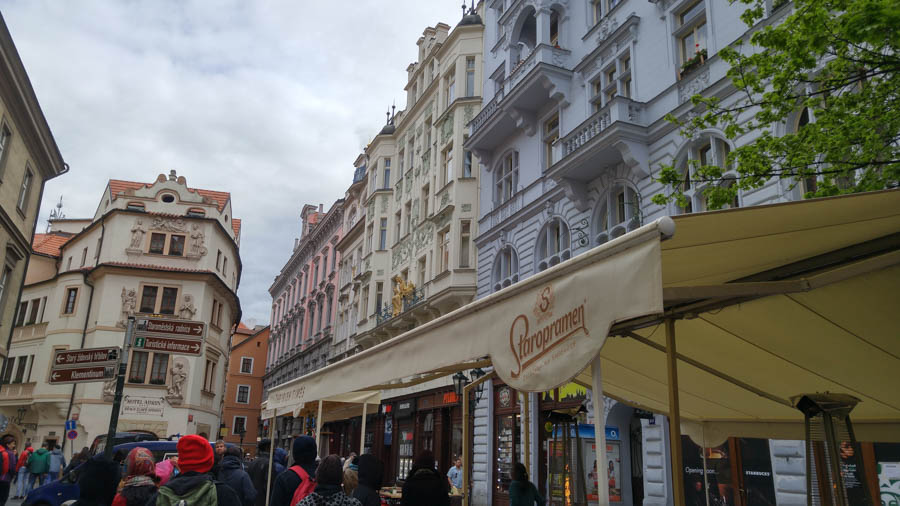
Just walking and seeing the sights
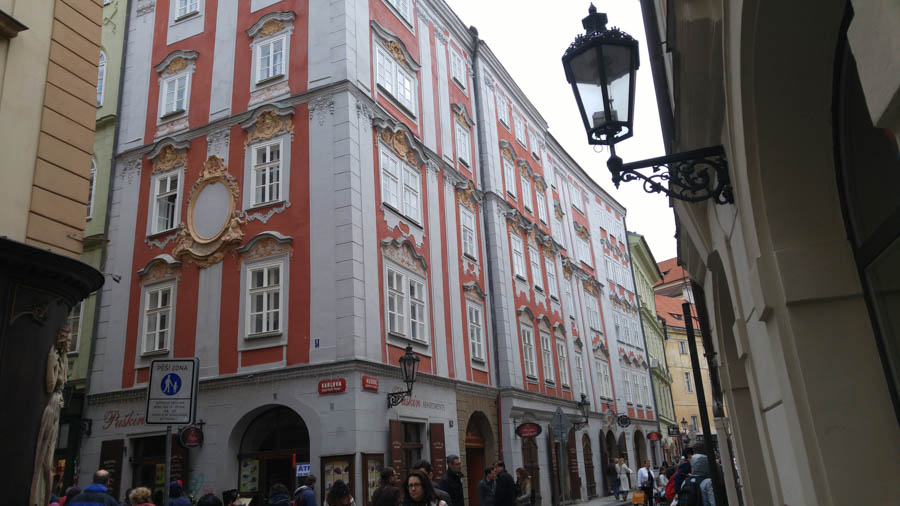
Seeing the sights and watching the people

Always dining and shopping

Old Town Square is a historic square in the Old Town quarter of Prague, the capital of the Czech Republic. It is located between Wenceslas Square and the Charles Bridge.

Click to see the panoramic of the Old Town Square

The Astronomy Clock
Did You Know? - The clock was first installed in 1410, making it the third-oldest astronomical clock in the world and the oldest one still operating.
The Orloj is mounted on the southern wall of Old Town Hall in the Old Town Square. The clock mechanism itself has three main components: the astronomical dial, representing the position of the Sun and Moon in the sky and displaying various astronomical details; "The Walk of the Apostles", a clockwork hourly show of figures of the Apostles and other moving sculptures—notably a figure of Death (represented by a skeleton) striking the time; and a calendar dial with medallions representing the months.
According to local legend, the city will suffer if the clock is neglected and its good operation is placed in jeopardy; a ghost, mounted on the clock, was supposed to nod its head in confirmation. According to the legend, the only hope was represented by a boy born on New Year's night.
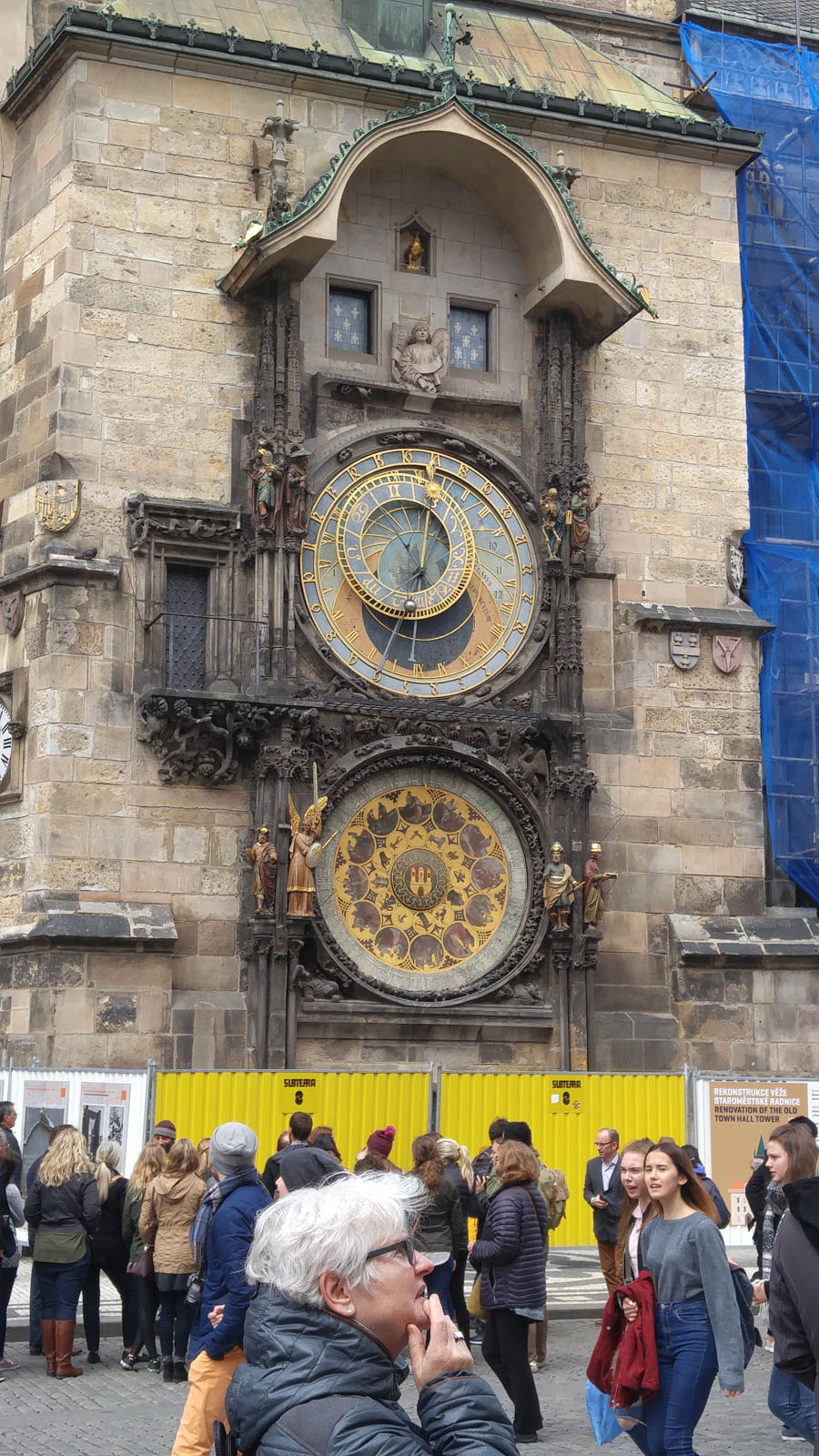
An amazing piece of engineering
Did You Know? - The Orloj suffered heavy damage on May 7 and especially May 8, 1945, during the Prague Uprising, when the Germans fired on the south-west side of the Old Town Square from several armored vehicles in an unsuccessful attempt to destroy one of the centers of the uprising. The hall and nearby buildings burned along with the wooden sculptures on the clock and the calendar dial face made by Josef Mánes.[4] After significant effort, the machinery was repaired, the wooden Apostles restored by Vojtěch Sucharda, and the Orloj started working again in 1948.
The Orloj was renovated in autumn 2005, when the statues and the lower calendar ring were restored. The wooden statues were covered with a net to keep pigeons away.
Now, in July 2017, the Orloy is again being renovated.

It gets a lot of visitors amazed at the workmanship and engineering

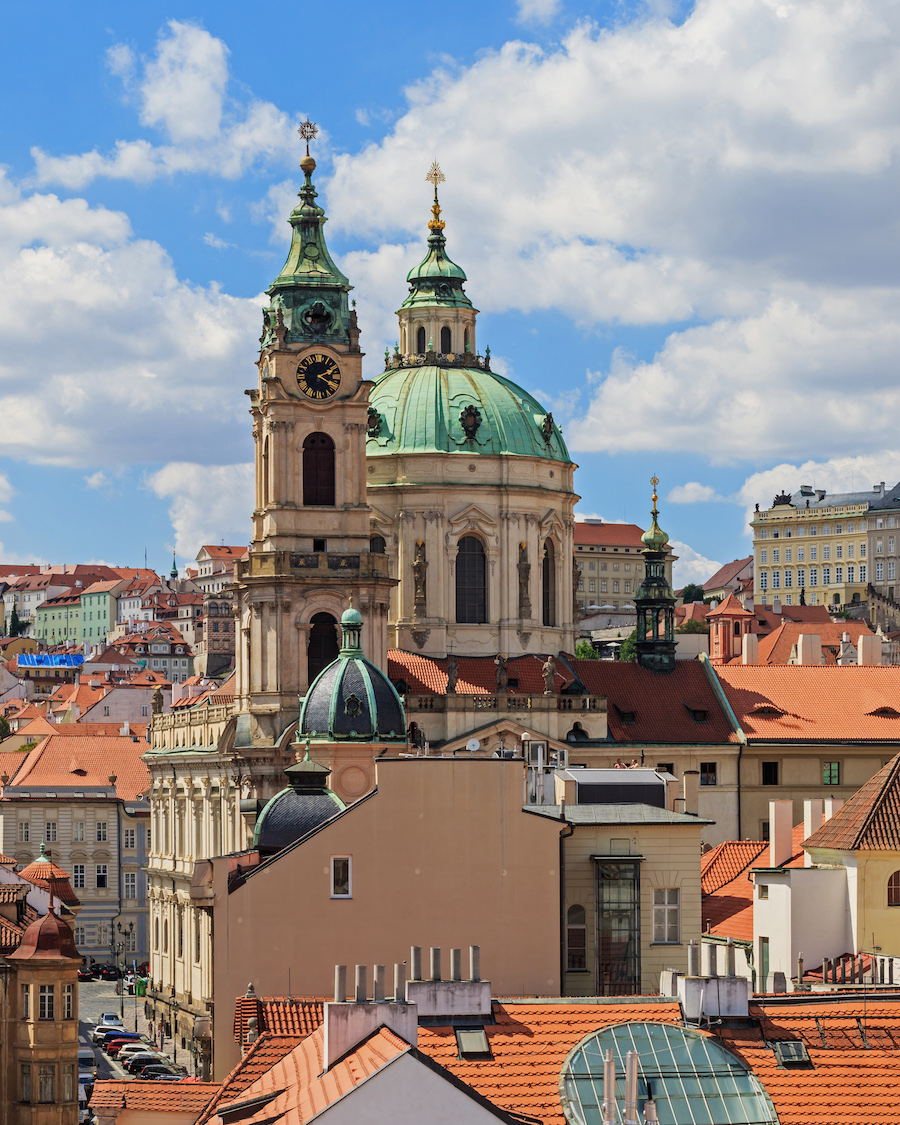
The Church of Saint Nicholas is a Baroque church in the Lesser Town of Prague. It was built between 1704-1755 on the site where formerly a Gothic church from the 13th century stood, which was also dedicated to Saint Nicholas.

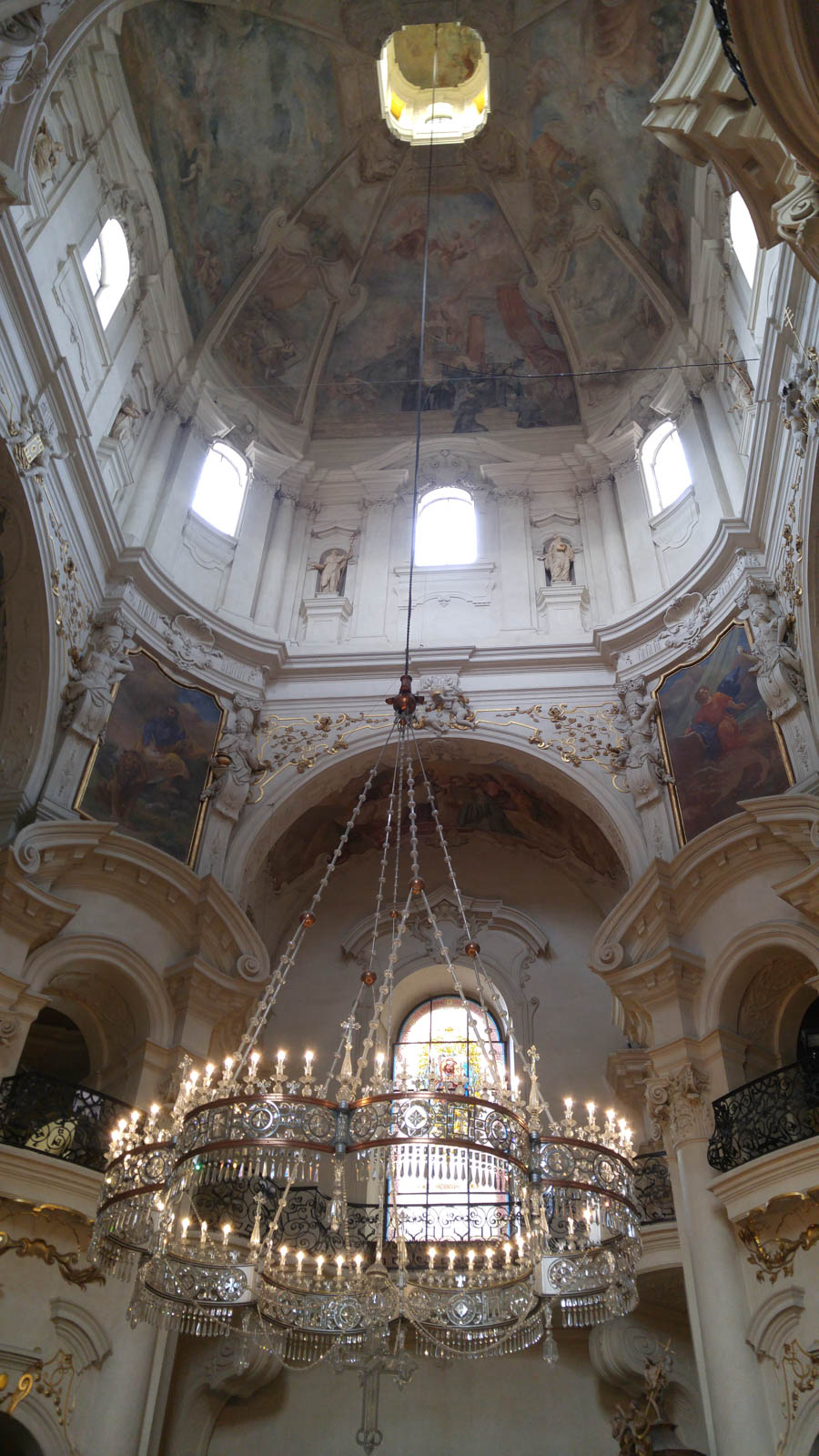
Full time job just keeping the bulbs replaced!
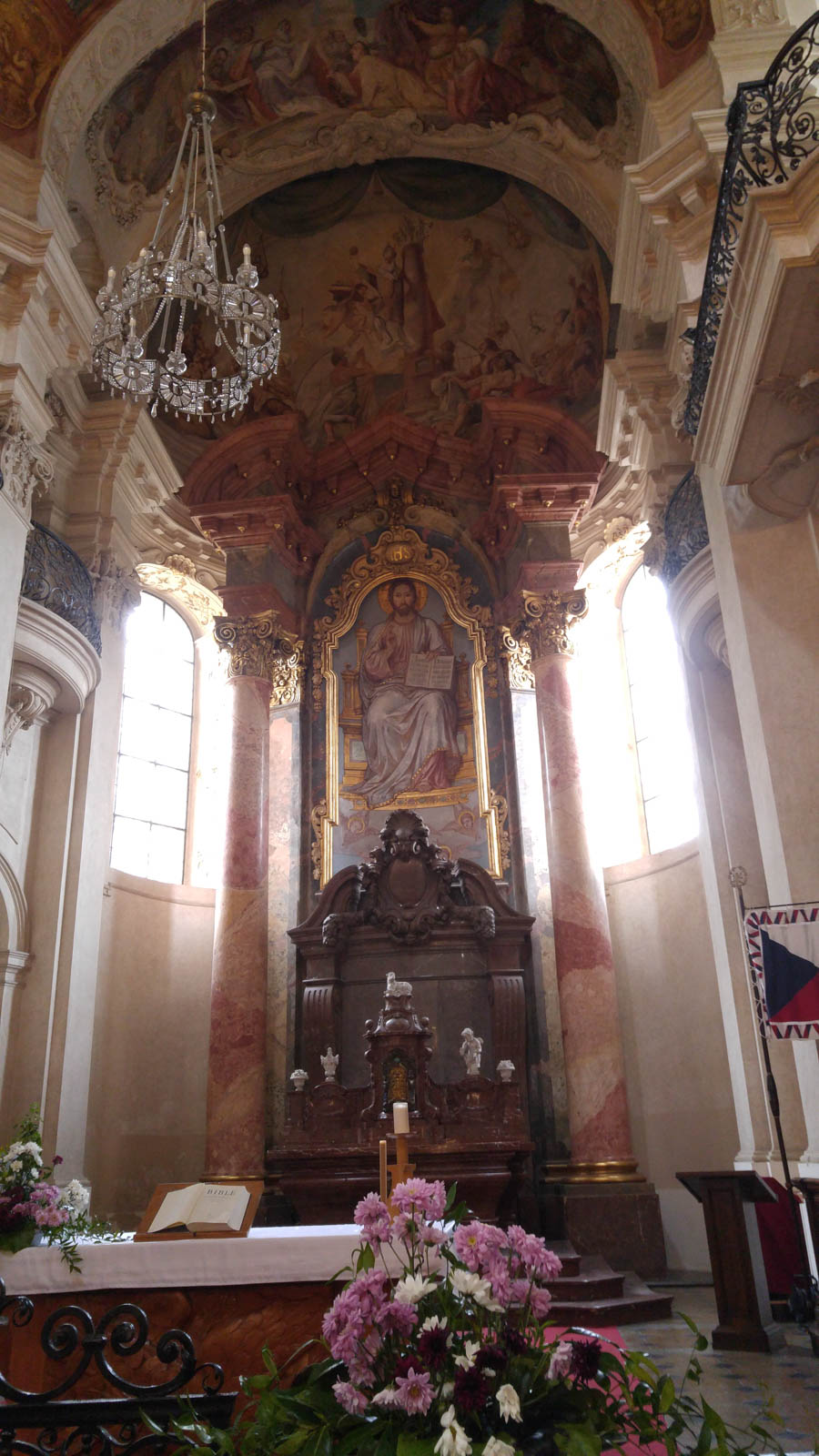
Beautiful altar
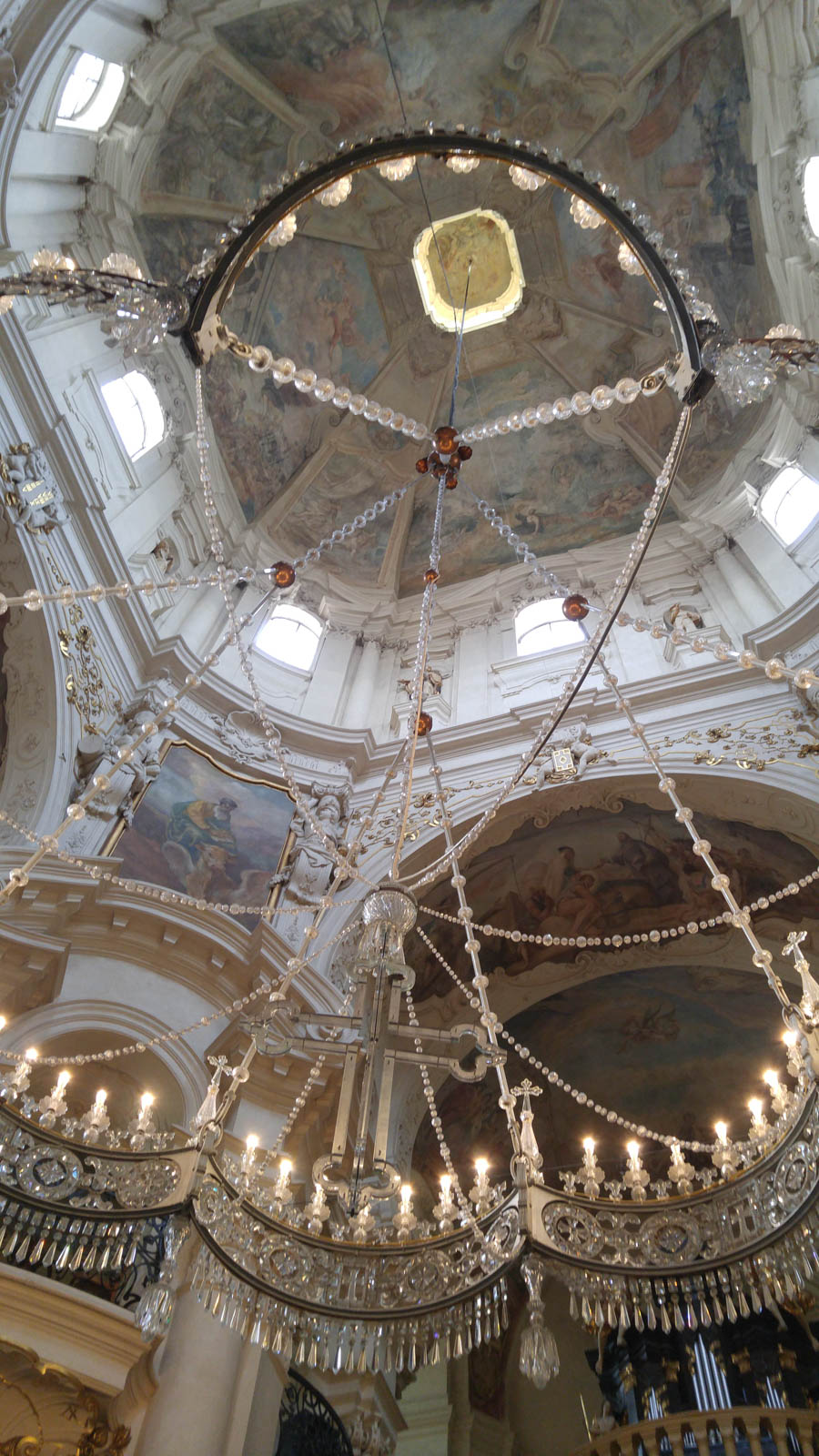
Quite a sight to see
Did You Know? - The church excels not only in the architecture, but also in the decoration, mainly with the frescoes by Jan Lukas Kracker and a fresco inside the 70 m high dome by František Xaver Palko. The interior is further decorated with sculptures by František Ignác Platzer. The Baroque organ has over 4,000 pipes up to six metres in length and was played by Mozart in 1787. Mozart's spectacular masterpiece, Mass in C, was first performed in the Church of Saint Nicholas shortly after his visit.
The 79 m tall belfry is directly connected with the church’s massive dome. The belfry with great panoramic view, was unlike the church completed in Rococo forms in 1751-1756 by Anselmo Lurago.

The Church Of Our Lady is also on Old Town Square
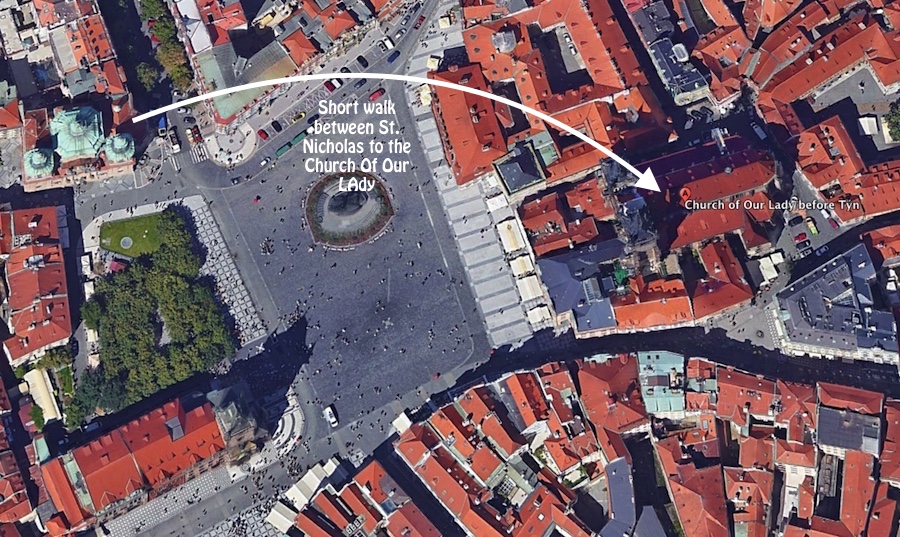
Did You Know? - The Church of Mother of God before Týn, often translated as Church of Our Lady before Týn, is a gothic church and a dominant feature of the Old Town of Prague, Czech Republic. It has been the main church of this part of the city since the 14th century. The church's towers are 80 m high and topped by four small spires.

Leaving Old Town Square
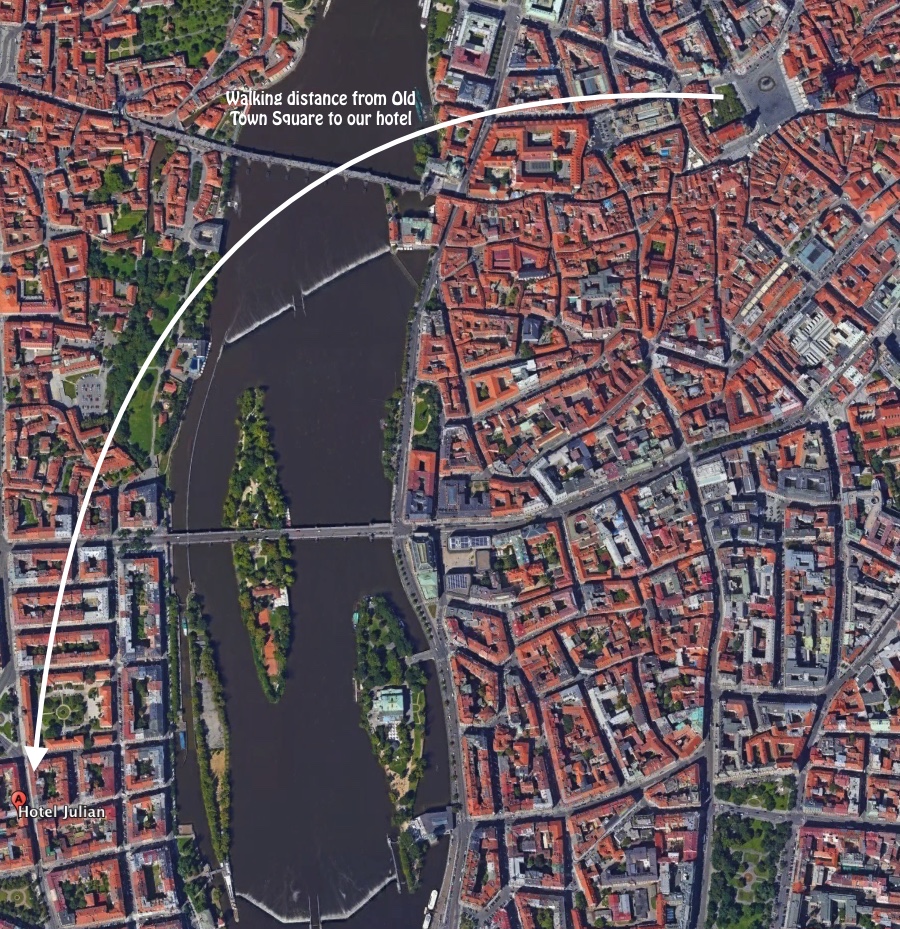
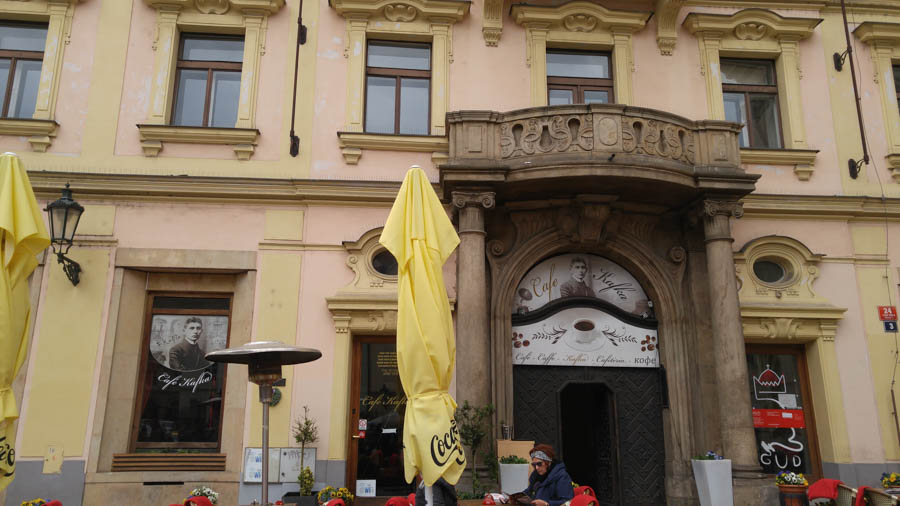
Time for a snack...

The Pinkas Synagogue
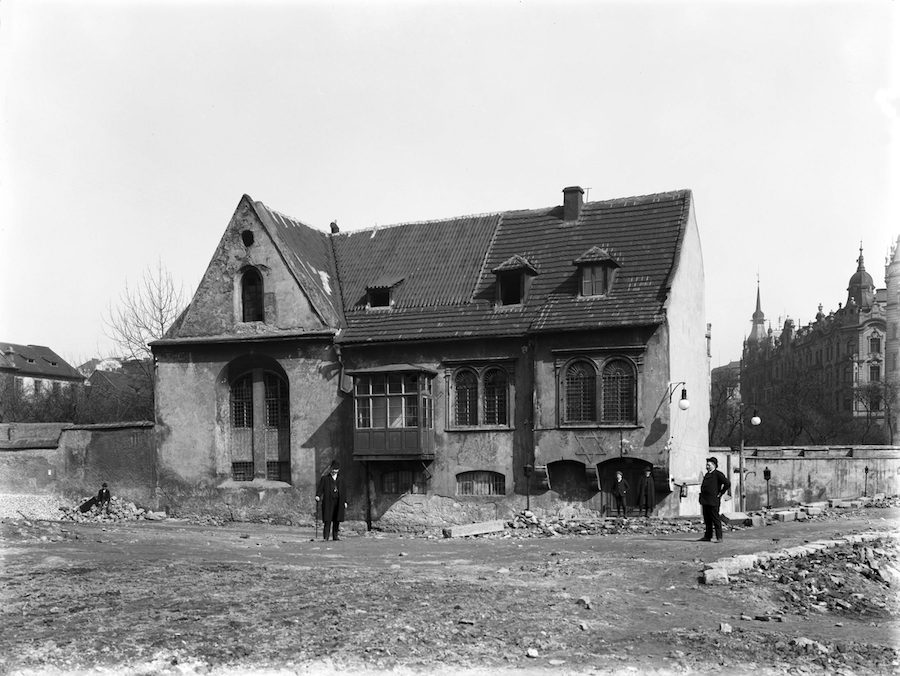
Pinkas Synagogue in 1909, during the urban renewal
of the so-called Jewish Town in Prague
Did You Know? - The Pinkas Synagogue is the second oldest surviving synagogue in Prague. Its origins are connected with the Horowitz family, a renowned Jewish family in Prague. Today, the synagogue is administered by the Jewish Museum in Prague and commemorates about 78,000 Czech Jewish victims of the Shoah.

The Jewish conclave in Prague
Did You Know? - Jews are believed to have settled in Prague as early as the 10th century. The first pogrom was in 1096 (the first crusade) and eventually they were concentrated within a walled Ghetto. In 1262 Přemysl Otakar II issued a Statuta Judaeorum which granted the community a degree of self-administration. In 1389 one of the worst pogroms saw some 1,500 massacred at Easter Sunday. The ghetto was most prosperous towards the end of the 16th century when the Jewish Mayor, Mordecai Maisel, became the Minister of Finance and a very wealthy man. His money helped develop the ghetto.
In 1850 the quarter was renamed "Josefstadt" (Joseph's City) after Joseph II, Holy Roman Emperor who emancipated Jews with the Toleration Edict in 1781. Two years before Jews were allowed to settle outside of the city, so the share of the Jewish population in Josefov decreased, while only orthodox and poor Jews remained living there.
Most of the quarter was demolished between 1893 and 1913 as part of an initiative to model the city on Paris. What was left were only six synagogues, the old cemetery, and the Old Jewish Town Hall (now all part of the Jewish Museum in Prague and described below).
Currently Josefov is overbuilt with buildings from the beginning of the 20th century, so it is difficult to appreciate exactly what the old quarter was like when it was reputed to have over 18,000 inhabitants. Medieval Josefov is depicted in the 1920 film The Golem, composed of cramped, angular, squinted buildings, but this impression is used purely to convey the expressionist nature of the film.

The King Solomon Restaurant delivers
Did You Know? - King Solomon Restaurant, the oldest kosher restaurant in the Czech Republic, offers the very best of traditional Jewish cuisine from Central and Eastern Europe. We welcome you to discover for yourself the pleasure of dining with the very best in kosher culinary experiences.
After over 10 years in the market, we have established a world-renowned reputation for excellent cuisine in the charming neighborhood of the Jewish Quarter of Prague. We offer only the best from our Czech breeders – veal, fallow deer, lamb and A class kosher chicken. Poultry of the highest quality is imported from the top breeders in France, Belgium and Austria. Many of our standard meats and ingredients also carry bio certificates or „highest quality of origin" certificates. Fish (preferably local) is served fresh. We are strongly opposed to mass killings of breeds and we do not support wasteful usage of resources to transport products from around the globe.
On our menu you will find many traditional Jewish dishes from our region, such as Golden chicken broth with matzoh dumpling and almonds, Gefilte fish in vinegar jelly with grated beetroot, Veal Kishke tripe filled skins, Duck leg baked in soulet, Lamb in thick carrot sauce, Deer back with latkes, Homemade breads or great oriental salads like Houmous, Tahini or Matboucha.


The Old-New Synagogue
Did You Know? - The Old New Synagogue or Altneuschul (Czech: Staronová synagoga; German: Altneu-Synagoge) situated in Josefov, Prague, is Europe's oldest active synagogue. It is also the oldest surviving medieval synagogue of twin-nave design.
Completed in 1270 in Gothic style, it was one of Prague's first Gothic buildings. A still older Prague synagogue, known as the Old Synagogue, was demolished in 1867 and replaced by the Spanish Synagogue.

We continue our walk to the hotel
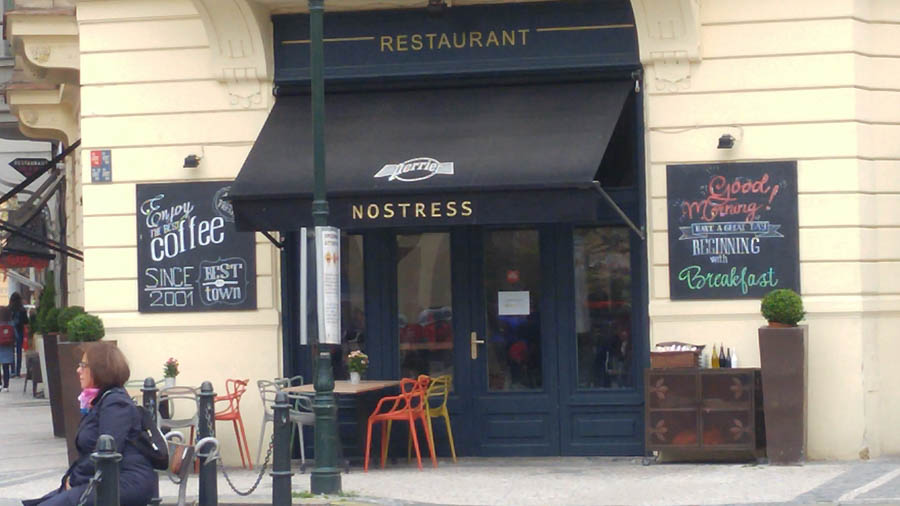
Coffee houses pop up everywhere
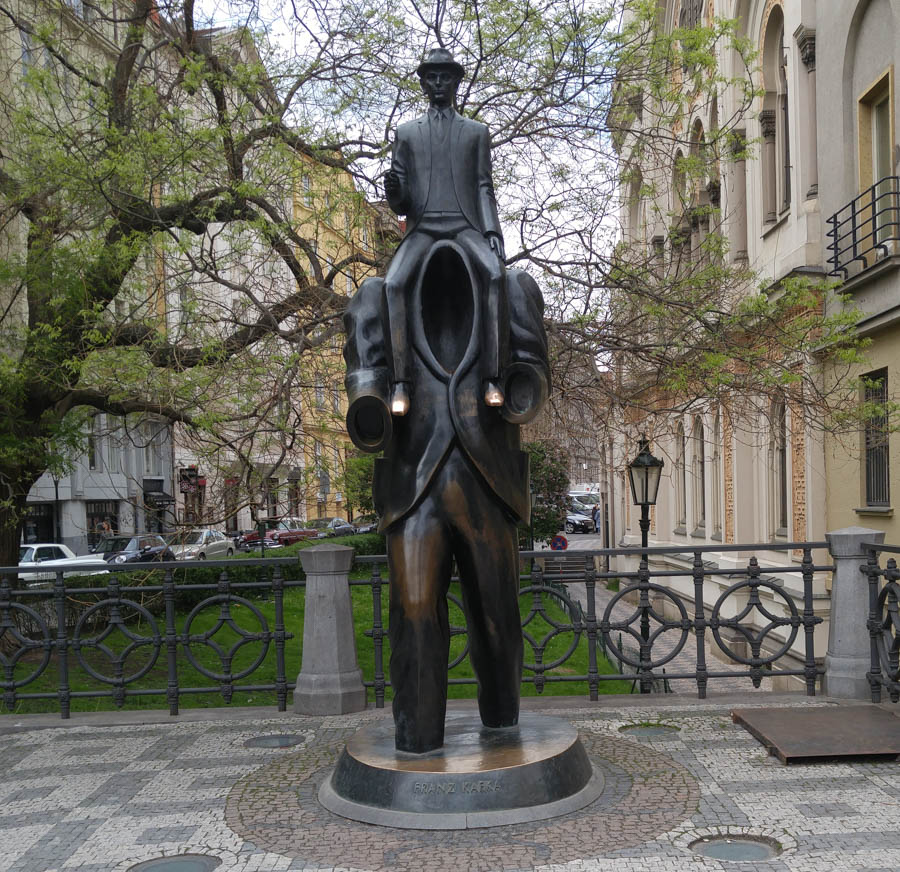
Jaroslav Róna's bronze statue of Franz Kafka in Prague
Did You Know? - Franz Kafka (3 July 1883 – 3 June 1924) was a German-language novelist and short story writer, widely regarded as one of the major figures of 20th-century literature. His work, which fuses elements of realism and the fantastic,[3] typically features isolated protagonists faced by bizarre or surrealistic predicaments and incomprehensible social-bureaucratic powers, and has been interpreted as exploring themes of alienation, existential anxiety, guilt, and absurdity.
Kafka was born into a middle-class, German-speaking Jewish family in Prague, the capital of the Kingdom of Bohemia, then part of the Austro-Hungarian Empire, today part of the Czech Republic. He trained as a lawyer, and after completing his legal education he was employed with an insurance company, forcing him to relegate writing to his spare time. Over the course of his life, Kafka wrote hundreds of letters to family and close friends, including his father, with whom he had a strained and formal relationship. He became engaged to several women but never married. He died in 1924 at the age of 40 from tuberculosis.

Standing tall!

50s-style diner with red leather booths, celebrity motifs &
a menu of burgers, steaks & sandwiches.

Entrance to the Municipal Ha
Did You Know? - Municipal House is a civic building that houses Smetana Hall, a celebrated concert venue, in Prague. It is located on Náměstí Republiky next to the Powder Gate in the center of the city

Today, the building is used as concert hall, ballroom, civic building, and includes cafes and restaurants. Many of the rooms in the building are closed to the public and open only for guided tours.
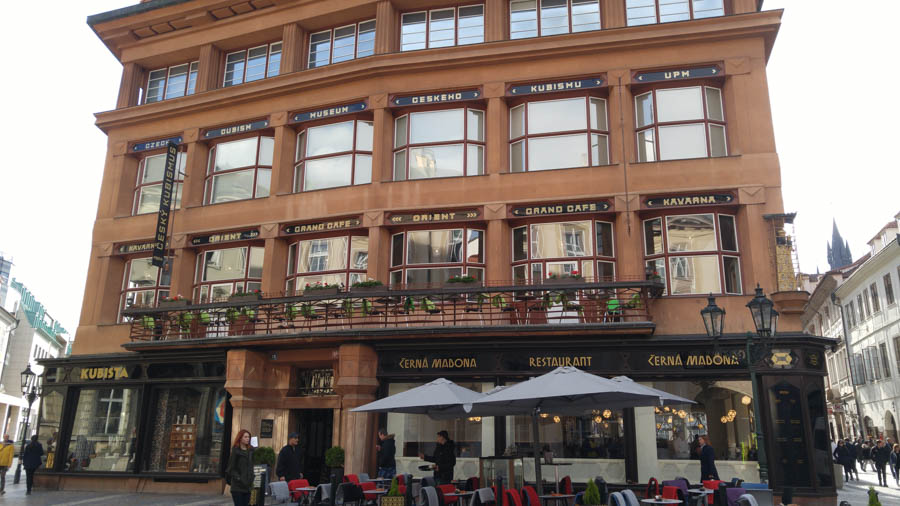
The House of the Black Madonna is located on the Old Town Square
Did You Know? - The House of the Black Madonna is a cubist building in the "Old Town" area of Prague, Czech Republic. It was designed by Josef Gočár. It is currently in use as the Czech Museum of Cubism and includes the Grand Café Orient restaurant on the first floor.
The House of the Black Mother (U Černé Matky Boží), sometimes referred to as Black Mother of the Lord, was designed and built between 1911 and 1912 on the corner of Celetná Street and Ovocný trh. Josef Gočár built the house as the first example of cubist architecture in Prague, and it remains probably the most celebrated.
Even without historical details of the baroque building surrounding it, the House at the Black Madonna maintains the atmosphere of the neighborhood. The house was given its name by the stone sculpture that originally adorned one of the two Baroque buildings on the same lot.

A cupola comes out onto the sidewalk
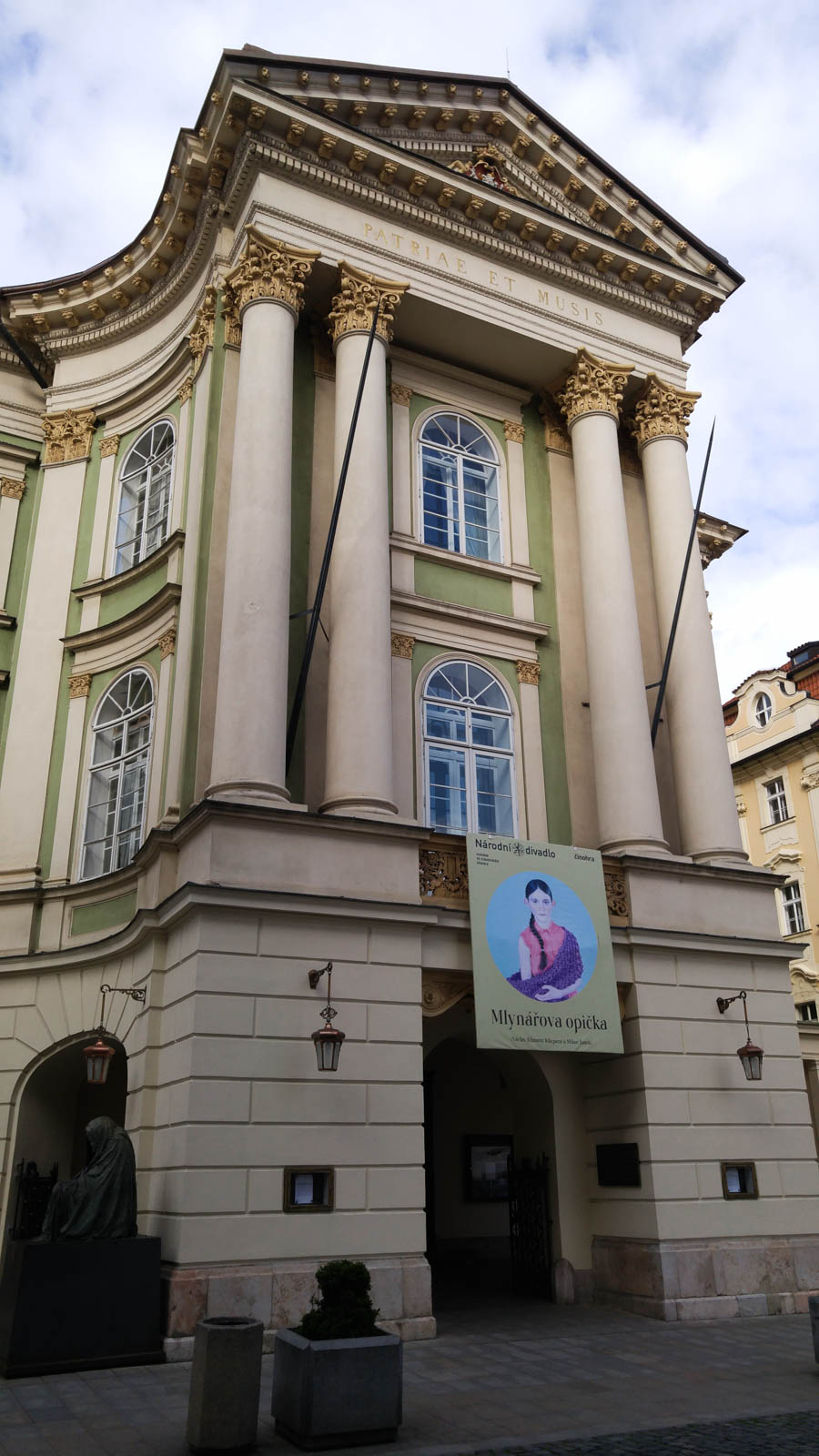
The local Opera House
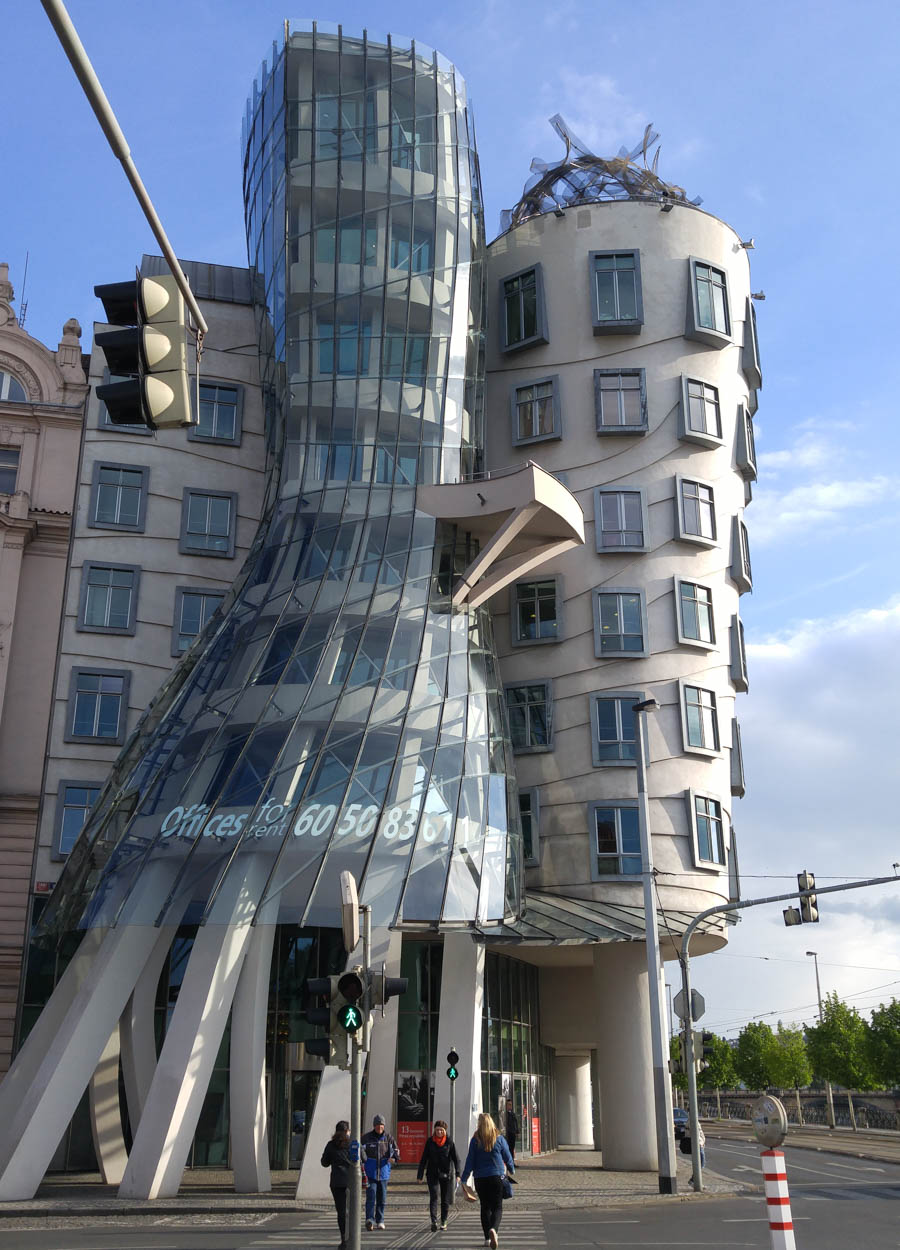
We passed by the "Dancing House"
Did You Know? - The Dancing House (Czech: Tančící dům), or Fred and Ginger, is the nickname given to the Nationale-Nederlanden building on the Rašínovo nábřeží (Rašín Embankment) in Prague, Czech Republic. It was designed by the Croatian-Czech architect Vlado Milunić in cooperation with Canadian-American architect Frank Gehry on a vacant riverfront plot. The building was designed in 1992 and completed in 1996.
The very non-traditional design was controversial at the time because the house stands out among the Baroque, Gothic and Art Nouveau buildings for which Prague is famous, and in the opinion of some it does not accord well with these architectural styles. The then Czech president, Václav Havel, who lived for decades next to the site, had avidly supported this project, hoping that the building would become a center of cultural activity.
Gehry originally named the house Fred and Ginger (after the famous dancers Fred Astaire and Ginger Rogers – the house resembles a pair of dancers) but this nickname is now rarely used; moreover, Gehry himself was later "afraid to import American Hollywood kitsch to Prague", and thus discarded his own idea.
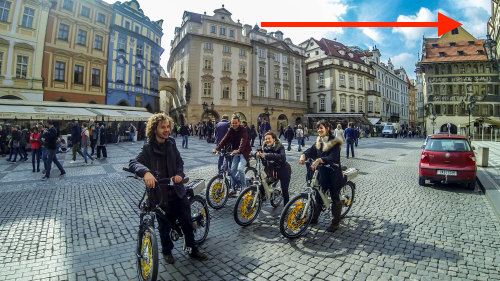
Continue to Day #3 and Flying Home